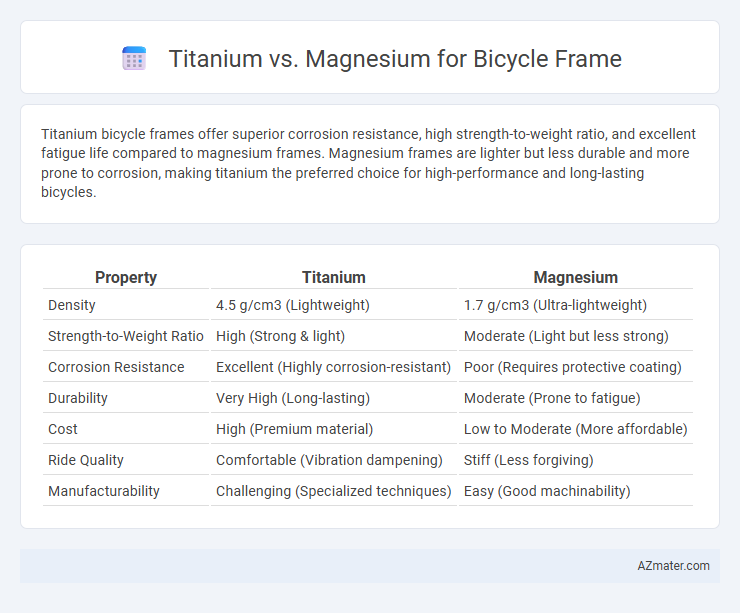Titanium bicycle frames offer superior corrosion resistance, high strength-to-weight ratio, and excellent fatigue life compared to magnesium frames. Magnesium frames are lighter but less durable and more prone to corrosion, making titanium the preferred choice for high-performance and long-lasting bicycles.
Table of Comparison
| Property | Titanium | Magnesium |
|---|---|---|
| Density | 4.5 g/cm3 (Lightweight) | 1.7 g/cm3 (Ultra-lightweight) |
| Strength-to-Weight Ratio | High (Strong & light) | Moderate (Light but less strong) |
| Corrosion Resistance | Excellent (Highly corrosion-resistant) | Poor (Requires protective coating) |
| Durability | Very High (Long-lasting) | Moderate (Prone to fatigue) |
| Cost | High (Premium material) | Low to Moderate (More affordable) |
| Ride Quality | Comfortable (Vibration dampening) | Stiff (Less forgiving) |
| Manufacturability | Challenging (Specialized techniques) | Easy (Good machinability) |
Introduction to Bicycle Frame Materials
Titanium offers exceptional strength-to-weight ratio and corrosion resistance, making it a premium choice for bicycle frames that require durability and comfort. Magnesium, known for its lightweight properties and vibration damping, provides an alternative for riders seeking agility and shock absorption in frame material. Both metals present unique benefits, with titanium favored for longevity and magnesium valued for its lightweight ride characteristics.
Overview of Titanium Frames
Titanium bicycle frames offer exceptional strength-to-weight ratio, corrosion resistance, and a smooth ride quality, making them a preferred choice for high-performance and long-distance cycling. Their durability and fatigue resistance surpass that of magnesium, providing longevity with minimal maintenance. While titanium frames are generally more expensive, their balance of lightweight design and vibration dampening justifies the investment for serious cyclists.
Overview of Magnesium Frames
Magnesium bicycle frames are valued for their lightweight properties, offering a significant reduction in overall bike weight compared to steel and aluminum frames. Their excellent vibration damping enhances ride comfort, making them favorable for off-road and long-distance cycling. Magnesium's corrosion resistance and ability to absorb shocks make it a durable and reliable choice for performance-oriented riders seeking both strength and agility.
Weight Comparison: Titanium vs Magnesium
Titanium bicycle frames typically weigh between 1,200 to 1,500 grams, offering a balance of strength and lightness ideal for performance cycling. Magnesium frames, lighter by nature, usually range from 900 to 1,200 grams, making them one of the lightest options available in bike frame materials. Despite the weight advantage of magnesium, titanium frames provide superior durability and fatigue resistance, critical for long-term cycling performance.
Strength and Durability Analysis
Titanium bicycle frames offer exceptional strength-to-weight ratios with high fatigue resistance, making them durable under repeated stress and ideal for long-term use. Magnesium frames, while lightweight and providing good shock absorption, generally have lower fatigue strength and may be more susceptible to corrosion without proper coating. The superior corrosion resistance and tensile strength of titanium contribute to its reputation for enduring harsh riding conditions and maintaining structural integrity over time.
Ride Quality and Comfort Differences
Titanium bicycle frames offer superior ride quality by combining strength and flexibility, which dampens road vibrations and enhances long-distance comfort. Magnesium frames are lighter but tend to transmit more road buzz, resulting in a harsher ride compared to titanium. Cyclists seeking a smoother, more compliant ride often prefer titanium due to its natural shock absorption and fatigue resistance.
Corrosion Resistance and Longevity
Titanium bicycle frames offer superior corrosion resistance due to their stable oxide layer, which prevents rust and degradation over time. Magnesium frames, while lightweight, are prone to corrosion unless treated with protective coatings, limiting their longevity in humid or wet conditions. For durability and long-term performance, titanium remains the preferred choice among cyclists seeking a corrosion-resistant and long-lasting frame.
Cost and Market Availability
Titanium bicycle frames typically cost between $1,500 and $4,000, reflecting the metal's exceptional strength-to-weight ratio and corrosion resistance, but this price range limits availability to premium and custom-built markets. Magnesium frames, though lighter and less expensive to produce--often priced around $1,000 to $2,000--face limited market penetration due to durability concerns and less widespread manufacturing expertise. Market availability shows titanium dominates high-end, niche segments, while magnesium remains a niche option with potential for growth as production and material technologies improve.
Environmental Impact and Sustainability
Titanium offers exceptional corrosion resistance and longevity, reducing the need for frequent replacements and minimizing environmental waste over time. Magnesium frames are lighter and can be recycled efficiently, but their production involves higher energy consumption and potential environmental hazards due to mining processes. Choosing titanium supports sustainability through durability and reduced resource depletion, while magnesium's recyclability provides benefits in circular economy efforts despite its more resource-intensive production.
Which Frame Material is Better for You?
Titanium bicycle frames offer exceptional durability, corrosion resistance, and a smooth ride, making them ideal for long-term investment and rough terrain. Magnesium frames are lightweight and provide excellent shock absorption, favored for speed and agility in competitive cycling. Choosing the better frame material depends on your riding style, budget, and preference for weight versus comfort and longevity.

Infographic: Titanium vs Magnesium for Bicycle Frame
 azmater.com
azmater.com